Szacsva
y Pál
Empire in Different Colours was an exhibition
and temporary research room over two months in Spring 2004 at Ludwig
Museum Budapest. The exhibited artwork (the Empire installation) and
documents reflected on the book entitled Empire by Antonio Negri and
Michael Hardt (Harvard University Press, 2000) and invited the audience
as well to reflect on it. The research station installed beside the
artistic work consisted of A4 format printed readers put together by
the artist. One of the readers were made up by print outs of different
web-pages containing documents, critical essays and reviews on Empire.
Another reader contained studies by curators and art historians (also
printed out from the web) who made reference to or used quotations from
this book, in their writings about art. A third one contained different
texts by and interviews with other authors dealing with issues connected
to the process of globalisation and the role the US plays in it. The
research corner was equipped with an internet terminal where people
could make further explorations, and with a photocopy machine which
they could use for free to take home copies of the documents. Why a
show on this book?
I first met the title of the book of Negri and Hardt while reading the
texts of art theorists and especially the writings and interviews of
curators of major art exhibitions, who quoted it at a rate that reached
the number of the quotations of Foucault, Deleuze or Borges in similar
writings and talks on art (see for instance the number of quotations
of Empire in the catalogue of Documenta XI.).
The exceptional respect manifested towards this book on behalf of so
many famous professionals in the field of art theory and curatorial
practice, and the message this book emanates through their quotations
raised this treatise to the position of a "meta-discourse"
in my eyes. So, I went to the library and borrowed Empire. I started
my reading with enthusiasm, while going through the preface in which
the authors give a brief exposition of their theses and present the
main topics they engage to discuss on the next 400 +100 pages of their
book. This was extremely promising. But reading further and merging
deeper and deeper into the text, I gradually became disappointed. I
was not dissatisfied with the topics discussed by the authors. They
are my favorite ones. I was not displeased neither by the - supposed
- political and ideological engagement of the authors. I feel the same
bad about neo liberalism and neo conservative right wing populism gaining
more and more terrain around the world as the authors of Empire seem
to feel. What I found extremely problematic about the book, was the
enormously self-contradictory character of the language and the strategy
of argumentation of the treatise, which unavoidably affects its whole
message.
After having read a number of reviews on the book, containing so many
useful remarks, I still felt it was interesting to make an art exhibition
about it and the story of its reception in the various cultural and
intellectual fields. It was interesting to see how the highly positive
evaluation on behalf of the art professionals contrasted with the rather
critical remarks made by the authors representing the other fields of
the human sciences, some of whom went so far to state that Empire is
utterly useless as a political analysis. (Documents illustrating this
contrast could be found at the research corner installed in the exhibition
room.) My artistic statement (expressed in the "Empire Installation")
concentrated on the book itself, namely on the multiple self contradictory
aspects of it, which in my view stay at the origin of the spectacular
differences to be found between its various interpretations. Most of
these contradictions were already discussed in the various publications
commenting on the book. There is however one aspect which I would like
to mention here because I found it was rather neglected by the theoreticians,
probably because it is not a strictly "scholarly issue". I
noticed that all along their book, the authors of Empire confront their
readers with a double task, the two constituents of which are totally
incompatible one with another. On the one hand the text demands a courageous
impetus on behalf of the reader to first decipher the message of the
treatise (written in a fairly heavy academic jargon) and then to further
reflect with creative imagination and critical attitude on the concepts
and ideas proposed by the authors. On the other hand, however, the often
messianic and prescriptive intonations of the writing call for a more
devotional approach, and inspire us to "follow" rather then
critically reflect. Hardt and Negri's text invites us to debate and
at the same time strives to seduce us to consent. The result is a special
kind of intellectual and emotional paralysis, which I would call an
"attitudinal crisis" one can experience in relation to the
text.
As a consequence, "Empire Installation" consisted of presenting
Negri and Hardt's book printed several times but always in different
formats and colors. This gesture can be understood as a proposal for
a symbolic solution meant to un-bend the tensions caused by the contradictory
effects of the book. In this way the text every time (in each format
and in each color) gains one distinct character. Because the text is
already originally so rich in different - often contradictory - messages,
when adding an extra tenor to the print, each time a different one of
those messages gets more emphasized, more dominant (making the text's
meaning gravitate towards the one intensified by the given format or
color). Empire in poster format means something else than Empire on
A/5. Empire in blue expresses something different than Empire in rose.
By choosing one or another version of the prints, the members of the
audience can symbolically make "a choice", which the authors
have apparently failed to make when deciding upon the final message
of their book.
In the same year (2004) another artistic evaluation of Empire was created.
A 7 minutes video with the title: A Walk Through Empire. This piece
can be regarded as a corrective reading of Negri and Hardt's book. The
video consists of a double narrative. Moving picture and "moving"
text are alternating in continuous succession during the whole piece.
On the one hand, the viewer is confronted with excerpts from the original
text, chosen through the fairly particular method of following with
the camera an innocent being - an ant - which walks through the pages
of the book and leads the viewer to read somewhat automatically the
words that are included into the frame. These words constitute themselves
into sentences and eventually they make up a little discourse... On
the other hand from time to time moving images interrupt the walk of
the ant. They form a parallel narrative to the verbal flow and seem
to respond to the enunciations "found" in the text. These
episodes are actually very short video recordings of anecdotic scenes
of the everyday street life, shot in different cities around Europe
and the US.
http://www.freeweb.hu/perimedia/empire.htm
Szacsva y Pál is an artist living and working in Budapest
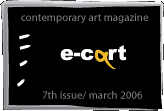 |
|
|
||||||||||||||||
 |
 |
 |
|
|||||||||||||||
| |
|
|||||||||||||||||
 |
|
|
|
|||||||||||||||
| |
|
|||||||||||||||||
 |
|
|||||||||||||||||
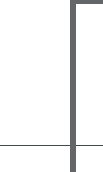 |
 |
|
 |
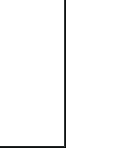 |
|
|||||||||||||
| |
 |
 |
|
|||||||||||||||
| |
|
|
||||||||||||||||
 |
 |
|
||||||||||||||||
 |
|
|
|
|||||||||||||||
| |
|
|
|
|
|
|||||||||||||
| |
|
|||||||||||||||||
| |
|
|||||||||||||||||
| |
|
|
||||||||||||||||
 |
|
|||||||||||||||||
 |
|
|||||||||||||||||
| |
|
|
||||||||||||||||
 |
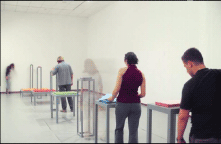 |
|
||||||||||||||||
| |
|
|
|
|
|
|
|
|
|
|
|
|
|
|
|
|
|
|